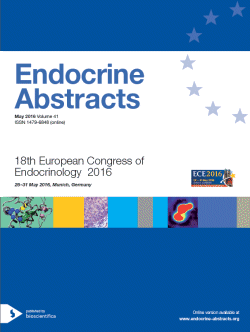Guided Posters
Obesity
ea0041gp129 | Obesity | ECE2016
Direct effects of dopamine on mitochondrial thermogenesis in brown adipocytes
Kohlie Rose , Perwitz Nina , Lehnert Hendrik , Klein Johannes , Iwen Alexander
ea0041gp130 | Obesity | ECE2016
Hypothalamic inflammation in humans is not reversed by a profound weight loss and an improved insulin sensitivity due to bariatric surgery
Kreutzer Carina , Peters Sonke , Schulte Dominik , Turk Kathrin , Wolff Stephan , Rohr Axel , Kerby Tina , Riedel Christian , van Eimeren Thilo , Schreiber Stefan , Laudes Matthias
ea0041gp131 | Obesity | ECE2016
The liver of obese patients with hepatic steatosis exhibits a severe dysregulation of key splicing machinery components as compared to obese patients without hepatic steatosis
Rio-Moreno Mercedes del , Pedraza-Arevalo Sergio , Gonzalez-Rubio Sandra , Ferrin Gustavo , Gahete Manuel D , Rodriguez-Peralvarez Manuel , Kineman Rhonda D , Ibanez-Costa Alejandro , de la Mata Manuel , Castano Justo P , Luque Raul M
ea0041gp132 | Obesity | ECE2016
The E3 ubiquitin ligase MDM2 acts as a key determinant of hepatic VLDL-triglycerides and ketone body production in obesity
Liu Zhuohao , Xu Aimin , Cheng Kenneth K Y
ea0041gp133 | Obesity | ECE2016
The ubiquitin-like pathway neddylation controls adipocyte differentiation, obesity and metabolism
Bauder Corinna , Labeur Marta , Vogl Annette , Wolfel Barbara , Wurst Wolfgang , Stalla Gunter , Refojo Damian
ea0041gp134 | Obesity | ECE2016
Prognostic factors and pathophysiology of diabetes remission after metabolic gastric bypass, sleeve gastrectomy and greater curvature plication: a randomized controlled trial
Vilarrasa Nuria , Casajoana Anna , de Gordejuela Amador R , Duran Xavier , Vendrell Joan , Fernandez Sonia , Garrido Pilar , Monseny Rosa , Pujol Jordi
ea0041gp135 | Obesity | ECE2016
Ventilatory anaerobic threshold six months after RYGB
Polovina Snezana , Nedeljekovic Ivana , Bajec Djordje , Sumarac-Dumanovic Mirjana , Radenkovic Dejan , Kendereški Aleksandra , Gregoric Pavle , Cvijovic Goran , Micic Dusan , Zoric Svetlana , Stamenkovic-Pejkovic Danica , Milin-Lazovic Jelena , Jeremic Danka , Gligic Ana , Micic Dragan
ea0041gp136 | Obesity | ECE2016
A novel human fetal brown stem cell functional model to study brown adipogenesis
Franco Alessandra Di , Guasti Daniele , Squecco Roberta , Mazzanti Benedetta , Rossi Francesca , Idrizaj Eglantina , Gallego-Escuredo Jose , Villarroya Francesc , Bani Daniele , Forti Gianni , Vannelli Gabriella Barbara , Luconi Michaela
ea0041gp137 | Obesity | ECE2016
Adipose tissue infiltration in normal-weight subjects and its impact on metabolic function
Moreno-Indias Isabel , Oliva-Olivera Wilfredo , Castellano-Castillo Daniel , Lhamyani Said , Fernandez-Garcia Jose Carlos , Queipo-Ortuno Maria Isabel , Cardona-Diaz Fernando , Tinahones Francisco
ea0041gp138 | Obesity | ECE2016
Dietary and weight loss effects on human gut microbiome diversity and metabolism
Fangmann Daniela , Heinsen Femke-Anouska , Schulte Dominik M , Ruhlemann Malte-Christoph , Turk Kathrin , Settgast Ute , Muller Nike , Lieb Wolfgang , Baines John F , Schreiber Stefan , Franke Andre , Laudes Matthias




